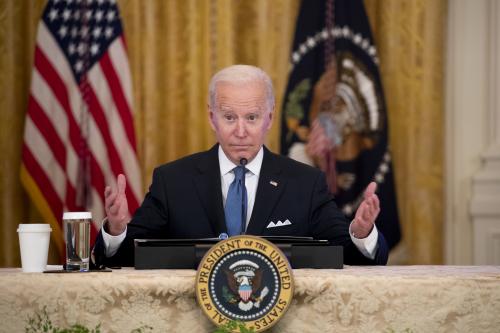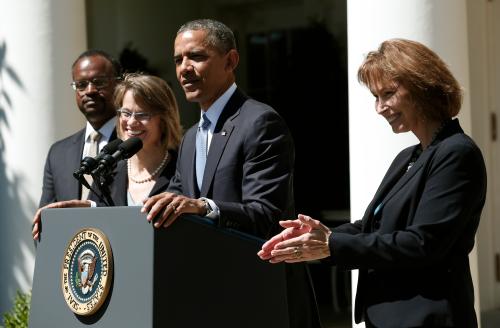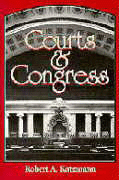The Kavanaugh nomination battle illustrates the degradation of the federal judicial confirmation process. Most recently, the current Senate majority has
- ignored a Democratic Supreme Court nominee eight months prior to a presidential election but rushed to confirm a Republican nominee four months before a Senate election;
- practically eliminated judicial confirmations in the eighth year of an opposing president’s term;
- eliminated consensus-building filibusters for Supreme Court nominees, citing a shaky 2013 precedent;
- jettisoned a blue slip process that it exploited under a Democratic president.
Assaults by both parties on traditional norms of judicial selection comity have dragged the judiciary into our polarized politics and raised vacancy rates that weaken the courts’ ability to do their main job: resolving civil and criminal cases.
Majority Leader Mitch McConnell (R-Ky.) said the Senate would ignore Merrick Garland, Obama’s March 2016 nominee to replace Justice Scalia, because “the American people are choosing their next president, and their next president should pick this Supreme Court nominee.”
The idea that the Senate should ignore a Democrat’s nominee “with a presidential election fast approaching” (eight months out) is tenuous at best. Accepting it for the sake of analysis, however, the only reason to confirm a Republican nominee with Senate election approaching even faster (four months out) is because there are the votes to do it or that the Senate is merely a rubber stamp, but it’s not.
Of the 31 Supreme Court nominees from 1916 to 1967, the Senate confirmed 19 with voice votes and a smattering of nay votes on the 12 roll calls. During that time, there were only three 20-plus nay votes, against Louis Brandeis (1916), former Associate Justice then 1916-Republican presidential candidate Charles Evans Hughes (1930) and Judge John Parker (1930), the only defeated nominee in the period. It disposed of nominees in a median of 15 days, a number inflated by the several months it took to confirm Brandeis and Potter Stewart (1959).
Starting with Thurgood Marshall in 1967 (not “starting with Bork”) there were no voice votes. For the 22 roll calls, the median nay vote count was 17 (a number depressed by four intermittent unanimous votes). Three nominees were defeated, three got over 40 nay votes, and four never got a vote (five counting the announced-but-never-submitted Douglas Ginsburg [1987]). Starting with George W. Bush, only John Roberts (2005) got fewer than 23 nay votes, and no other nominee got less than 31 (except Garland, and Harriett Miers [2005], who withdrew). Median days from nomination to confirmation vote was 65 days, quadruple the pre-Marshall period. The president still has the upper hand, but the Senate has become an active participant, and a different Senate might reject Kavanaugh or encourage a more centrist nominee.
McConnell justified confirming Kavanaugh because “…nobody on either side has ever suggested before yesterday that the Senate should only process Supreme Court nominees in odd-numbered years.” But he refused to process Democratic nominees in the (non-odd) eighth year, no doubt would have argued the same in the fourth year had Scalia died in 2012, and quite likely will reverse himself if a vacancy occurs in 2020.
Garland was not the only nominee whom the Senate stiffed in Obama’s eighth year. The 114th Senate record on district and circuit nominee confirmations broke with its predecessors’ treatment of what McConnell called “constitutionally lame-duck-presidenc[ies].” (McConnell’s use of “constitutionally” may suggest he carved out an opening should vacancies occur in the fourth year of President Trump’s first term.)
| Table 1: Nominations in Recent Presidents’ Eighth Years | ||||
|---|---|---|---|---|
| Year | White House Control | Senate Control | Circuit Confirmations | District Confirmations |
| 1988 | Rep | Dem | 7 | 33 |
| 2000 | Dem | Rep | 8 | 31 |
| 2008 | Rep | Dem | 4 | 24 |
| 2016 | Dem | Rep | 1 | 8 |
The obstructionism started in early 2015 (an odd-numbered year) with 7 circuit and 33 district vacancies, then shot up to 11 circuit and 75 district vacancies by September 2016, rising to 12 circuit and 125 district vacancies in early August 2018 (almost a fifth of all district judgeships). These district vacancies don’t affect Washington pressure groups but they wreak havoc with litigants, especially civil litigants seeking resolution of commercial or civil rights disputes, because criminal cases have statutory precedence.
The current Senate has further degraded the process by eliminating the filibuster for Supreme Court nominees. Fifty senators with a Pence tie-breaker can confirm a nominee with no bipartisan support. If Scalia’s and Kennedy’s successors needed 60 votes for confirmation, they might better reflect national preferences as evidenced in the 2016 popular vote, which Trump lost decisively.
It’s true that Democrats eliminated the filibuster for district and circuit nominees in November 2013, but compare the confirmation situation at that time to the comparable point in Bush’s presidency. Obama had fewer confirmations, lower confirmation rates, much longer time to confirmation for district judges and many more vacancies to fill.
| Table 2: Nominations in Bush 2 and Obama’s Fifth Years | |||||||
|---|---|---|---|---|---|---|---|
| District | Court of Appeals | ||||||
| Date | Vacancies* | Nom’s | Conf’s | Med. Days to Conf. | Nom’s | Conf’s | Med. Days to Conf. |
| 11/21/05 | 213 | 190 | 175 (92%) | 140 | 52 | 41 (79%) | 256 |
| 11/21/13 | 250 | 218 | 168 (77%) | 215 | 55 | 39 (71%) | 229 |
| *Includes vacancies at the start of term and those taking senior status. | |||||||
Obama’s final confirmation rates and numbers would have been even sparser than Bush’s without the 2013 intervention.
| Table 3: Overall Confirmation Records for Bush 2 and Obama | ||||||
|---|---|---|---|---|---|---|
| District | Court of Appeals | |||||
| Nom’s | Conf’s | Med. Days to Conf. | Nom’s | Conf’s | Med. Days to Conf. | |
| Bush 2 | 285 | 261 (92%) | 142 | 84 | 60 (71%) | 219 |
| Obama | 323 | 268 (83%) | 215 | 68 | 55 (81%) | 229 |
The 115th Senate has also trashed home-state senators’ blue-slip veto power over circuit nominees, a privilege that Democrats strictly but grumpily honored under Obama. Home-state Republican senators invoked it to keep many vacancies nominee-less—vacancies that Trump has now filled, as he has other vacancies for which Obama had submitted nominees that in normal times the Senate would confirm (explained here).
Democrats will respond in kind in the future when they get a Senate majority. If that happens with a Republican in the White House, confirmations will probably stop, as they pretty much did in 2015-16. Vacancies will increase. With a Democrat in the White House, the Senate will ram through nominees with little regard for the Republican minority.
These facts will not stop the Republican confirmation juggernaut from installing judges nominated by an unpopular president who entered office with a popular vote deficit that might have been even greater but for outside intervention. Assuming a party-line vote, Justice Kavanaugh will be the appointee of a president who got almost 3 million fewer popular votes than his major competitor, confirmed by a Republican Senate representing 43 percent of the national electorate. (If the three Democrats most likely to break ranks do so, the figure goes up only to 44 percent.) So much for the idea that presidential and senatorial elections are the proper way to put a popular imprint on the federal judiciary. The exercise of raw power will produce a short-term gain, but the continued loss of comity will further the long-term degradation of the judiciary.










Commentary
Kavanaugh aside, consider what’s happening to the courts
August 2, 2018